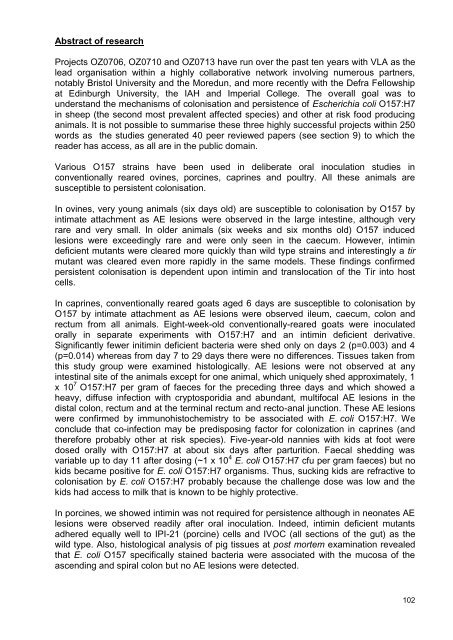Review of the Food-borne Zoonoses Research ... - ARCHIVE: Defra
Review of the Food-borne Zoonoses Research ... - ARCHIVE: Defra
Review of the Food-borne Zoonoses Research ... - ARCHIVE: Defra
Create successful ePaper yourself
Turn your PDF publications into a flip-book with our unique Google optimized e-Paper software.
Abstract <strong>of</strong> research<br />
Projects OZ0706, OZ0710 and OZ0713 have run over <strong>the</strong> past ten years with VLA as <strong>the</strong><br />
lead organisation within a highly collaborative network involving numerous partners,<br />
notably Bristol University and <strong>the</strong> Moredun, and more recently with <strong>the</strong> <strong>Defra</strong> Fellowship<br />
at Edinburgh University, <strong>the</strong> IAH and Imperial College. The overall goal was to<br />
understand <strong>the</strong> mechanisms <strong>of</strong> colonisation and persistence <strong>of</strong> Escherichia coli O157:H7<br />
in sheep (<strong>the</strong> second most prevalent affected species) and o<strong>the</strong>r at risk food producing<br />
animals. It is not possible to summarise <strong>the</strong>se three highly successful projects within 250<br />
words as <strong>the</strong> studies generated 40 peer reviewed papers (see section 9) to which <strong>the</strong><br />
reader has access, as all are in <strong>the</strong> public domain.<br />
Various O157 strains have been used in deliberate oral inoculation studies in<br />
conventionally reared ovines, porcines, caprines and poultry. All <strong>the</strong>se animals are<br />
susceptible to persistent colonisation.<br />
In ovines, very young animals (six days old) are susceptible to colonisation by O157 by<br />
intimate attachment as AE lesions were observed in <strong>the</strong> large intestine, although very<br />
rare and very small. In older animals (six weeks and six months old) O157 induced<br />
lesions were exceedingly rare and were only seen in <strong>the</strong> caecum. However, intimin<br />
deficient mutants were cleared more quickly than wild type strains and interestingly a tir<br />
mutant was cleared even more rapidly in <strong>the</strong> same models. These findings confirmed<br />
persistent colonisation is dependent upon intimin and translocation <strong>of</strong> <strong>the</strong> Tir into host<br />
cells.<br />
In caprines, conventionally reared goats aged 6 days are susceptible to colonisation by<br />
O157 by intimate attachment as AE lesions were observed ileum, caecum, colon and<br />
rectum from all animals. Eight-week-old conventionally-reared goats were inoculated<br />
orally in separate experiments with O157:H7 and an intimin deficient derivative.<br />
Significantly fewer initimin deficient bacteria were shed only on days 2 (p=0.003) and 4<br />
(p=0.014) whereas from day 7 to 29 days <strong>the</strong>re were no differences. Tissues taken from<br />
this study group were examined histologically. AE lesions were not observed at any<br />
intestinal site <strong>of</strong> <strong>the</strong> animals except for one animal, which uniquely shed approximately, 1<br />
x 10 7 O157:H7 per gram <strong>of</strong> faeces for <strong>the</strong> preceding three days and which showed a<br />
heavy, diffuse infection with cryptosporidia and abundant, multifocal AE lesions in <strong>the</strong><br />
distal colon, rectum and at <strong>the</strong> terminal rectum and recto-anal junction. These AE lesions<br />
were confirmed by immunohistochemistry to be associated with E. coli O157:H7. We<br />
conclude that co-infection may be predisposing factor for colonization in caprines (and<br />
<strong>the</strong>refore probably o<strong>the</strong>r at risk species). Five-year-old nannies with kids at foot were<br />
dosed orally with O157:H7 at about six days after parturition. Faecal shedding was<br />
variable up to day 11 after dosing (~1 x 10 4 E. coli O157:H7 cfu per gram faeces) but no<br />
kids became positive for E. coli O157:H7 organisms. Thus, sucking kids are refractive to<br />
colonisation by E. coli O157:H7 probably because <strong>the</strong> challenge dose was low and <strong>the</strong><br />
kids had access to milk that is known to be highly protective.<br />
In porcines, we showed intimin was not required for persistence although in neonates AE<br />
lesions were observed readily after oral inoculation. Indeed, intimin deficient mutants<br />
adhered equally well to IPI-21 (porcine) cells and IVOC (all sections <strong>of</strong> <strong>the</strong> gut) as <strong>the</strong><br />
wild type. Also, histological analysis <strong>of</strong> pig tissues at post mortem examination revealed<br />
that E. coli O157 specifically stained bacteria were associated with <strong>the</strong> mucosa <strong>of</strong> <strong>the</strong><br />
ascending and spiral colon but no AE lesions were detected.<br />
102

















